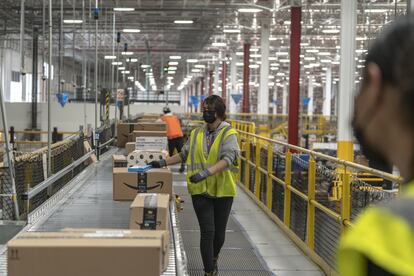Artificial intelligence will affect 60 million US and Mexican jobs within the year
IDB study shows the impact that AI will have on the labor market. Women and low-skilled workers are more vulnerable to being replaced

Artificial intelligence’s impact on our lives is already well-known, but now, its most feared consequences related to the job market are setting off alarms. An innovative index created by the Inter-American Development Bank shows that in the United States, 43 million jobs will be affected by the introduction of AI in the space of just one year. In Mexico, that figure stands at 16 million jobs. Over the next five years, those numbers will rise to 60 and 22 million, respectively. In the space of a decade, 70 million jobs in the U.S. will suffer, along with 26 million in its neighboring country.
“These estimates do not directly correspond to job losses, but they do indicate that a large proportion of occupations are vulnerable, and that there is an opportunity to leverage the jobs that will be most affected. We must have a plan for the impact that AI could have,” says Eric Parrado, chief economist at the IDB and co-author of the index.
The AI-Generated Index of Occupational Exposure calculates the potential impact of artificial intelligence on occupations and their associated tasks among more than 750 professions on one, five and 10-year timelines. It is based on large data sets, which it processes and synthesizes quickly, offering an alternative to traditional surveys, which are usually expensive.
According to the index, 980 million jobs around the world will be affected in some way by this new technology within the year. That amounts to 28% of the global workforce. Within five years, that figure will rise to between 38%, and in 10 years, 44%.
Those are compelling numbers, and while they don’t equate to jobs that will be necessarily lost, the fact that AI will impact nearly half of the world’s employment in some way implies that we are looking at a change of a magnitude similar to that which followed the 19th-century industrial revolution. “This is an industrial revolution that is growing exponentially. It’s going to take less time to implement. We must make adjustments quickly and that’s why we are carrying out this research, to send a message of caution,” says Parrado. The goal of the index is to serve as a warning, so that, instead of having negative consequences, AI will bring benefits.
“We are optimistic, we think that technological change will raise productivity. The fact that there will be job replacement doesn’t mean that employment will fall, because there will be opportunities that come up to create new occupations. We’ve seen it happen in the past. We have had very pronounced technological shocks, and they haven’t led to a decrease in employment, but rather a readjustment in the job markets,” says Parrado.
To turn what seems at first glance a crisis in the job market into a benefit, the study’s authors make recommendations that should be followed by companies and governments. Education and training are the factors that will have the highest impact on the success of adapting to this new reality. “We recommend a significant investment in education and re-training programs that should focus on developing skills that are complementary to AI, such as in areas of critical thinking, creativity and emotional intelligence,” says Parrado.
Women, the most vulnerable population
It also recommends supporting groups who are most vulnerable to the change, like women, who will be more deeply impacted due to the kinds of positions they occupy. “Women, in the United States as well as Mexico, are more vulnerable on the three timelines that we studied because they hold more office, administrative, service and support jobs that are vulnerable to AI. 40% of women will be affected by task automation, which is greater than the 38% of men who will be impacted. It’s important that this gender disparity be considered when it comes to setting policy,” says Parrado.
Vulnerability also varies throughout the socioeconomic hierarchy. Workers with less education and those whose jobs require less training will be more affected. When it comes to income, in the United States, people who earn less will be more vulnerable, while in Mexico, the change will impact both working-class and middle-class jobs. “AI could exacerbate global inequality, that’s why we have to act fast,” says Parrado.
The risk also varies by field. Workers whose jobs require more subjective criteria will be more difficult to replace. The index includes a list of the most and least vulnerable positions. In the former category are occupations like telephone operator, telemarketing, credit evaluators, machine operators and travel agencies, among others. In some cases, such as that of telephone operators, 92% of all positions will be affected.
Firefighters and athletes, irreplaceable
On the other hand, there are some positions that will beat the AI changes, like those tied to sports, teaching and firefighting. One of the innovative aspects of the index is that it differentiates between tasks that each profession performs. It found that there are specialties within each profession that are more easily replaced than others. For example, in the field of medicine, it’s more likely that a radiologist will lose their job as compared to a psychologist, a maxillofacial surgeon or even a nurse.
No analysis has been done on the differences of AI vulnerability by race or origin, but knowing that African Americans and Latinos occupy more low-income jobs, it’s easy to extrapolate that they will be more affected by the development of new technology.
The goal of the IDB study is drive public and private policy towards counteracting the negative effects that AI will bring. In addition to education and training programs for workers to adapt to the transformation, it recommends that governments improve social safety nets, especially in the short term, including instituting more robust employment insurance and subsidies for individual workers to help in their transition to the new labor model. It also advises the promotion of ethical development, support for small businesses, and periodic evaluations of the labor market.
To take on a transformation of this scale, Parrado says that it will also be necessary to adapt educational programs, urging governments to include AI in school curriculums because, “this technological change is here to stay,” he says.
Sign up for our weekly newsletter to get more English-language news coverage from EL PAÍS USA Edition
Tu suscripción se está usando en otro dispositivo
¿Quieres añadir otro usuario a tu suscripción?
Si continúas leyendo en este dispositivo, no se podrá leer en el otro.
FlechaTu suscripción se está usando en otro dispositivo y solo puedes acceder a EL PAÍS desde un dispositivo a la vez.
Si quieres compartir tu cuenta, cambia tu suscripción a la modalidad Premium, así podrás añadir otro usuario. Cada uno accederá con su propia cuenta de email, lo que os permitirá personalizar vuestra experiencia en EL PAÍS.
En el caso de no saber quién está usando tu cuenta, te recomendamos cambiar tu contraseña aquí.
Si decides continuar compartiendo tu cuenta, este mensaje se mostrará en tu dispositivo y en el de la otra persona que está usando tu cuenta de forma indefinida, afectando a tu experiencia de lectura. Puedes consultar aquí los términos y condiciones de la suscripción digital.










































